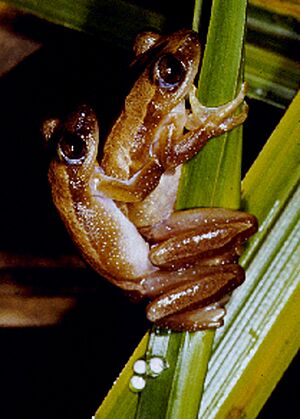Afrixalus fornasini facts for kids
Quick facts for kids Afrixalus fornasini |
|
|---|---|
 |
|
| Conservation status | |
| Scientific classification |
Meet the Fornasini's spiny reed frog, also known as the greater leaf-folding frog! This cool little frog lives in Africa and belongs to a family called Hyperoliidae. It got its name, fornasini, from an Italian nature lover named Carlo Antonio Fornasini, who first found one of these frogs.
Contents
Where Fornasini's Spiny Reed Frogs Live
Where does this frog live? You can find the Fornasini's spiny reed frog in several countries in southern and eastern Africa. These include Kenya, Tanzania, Malawi, Mozambique, Zimbabwe, South Africa, and possibly Eswatini.
Frog Habitats: Where They Call Home
These frogs are not picky about where they live! Their natural homes, called habitats, include many different places. They can be found in forests, dry or moist grasslands, and areas with lots of bushes. They also love wet places like swamps, freshwater marshes, and ponds. Sometimes, they even live in places where water collects, like temporary puddles.
How We Protect Fornasini's Spiny Reed Frogs
While these frogs are quite common in many areas, some parts of their home are shrinking. This is called habitat loss, and it can be a threat to the frogs. However, overall, the Fornasini's spiny reed frog is not considered rare. In fact, in some places, you might find many of them!
What Do Fornasini's Spiny Reed Frogs Eat?
Both male and female adult Fornasini's spiny reed frogs have an interesting diet. They like to eat the eggs and tadpoles of other frogs, like the grey foam-nest tree frog. This frog is special because it's the first African frog known to eat the eggs of other frogs from its own family.
Amazing Camouflage: How Frogs Hide
The way this frog hides from predators is truly amazing! It uses a special trick called "coincident disruptive coloration." This is a type of camouflage that helps the frog blend in with its surroundings.
How Their Camouflage Works
Imagine a frog with bold stripes on its legs and body. When the frog rests, it folds its legs tightly against its body. The stripes on its legs line up perfectly with the stripes on its body! This makes it really hard to see the frog's true shape. It breaks up its outline, making it look like part of the background.
Natural Selection and Survival
Scientists like Hugh Cott studied this frog's camouflage. They realized that such a clever hiding trick must be very helpful for the frog's survival. If a frog can hide better, it's less likely to be eaten. This idea is part of something called natural selection. It means that animals with helpful traits, like great camouflage, are more likely to survive and have babies. Over time, these helpful traits become more common in the frog population.
Gallery
-
A Fornasini's spiny reed frog on a leaf of a Jatropha curcas plant








